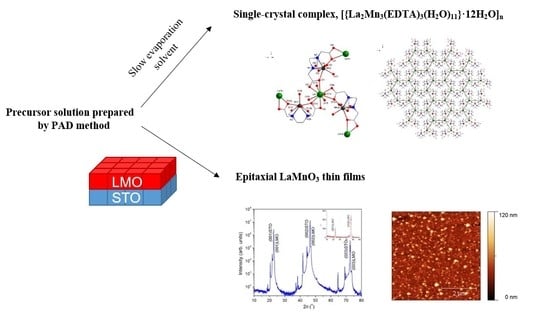Single Source Precursor for PAD-LaMnO3 Thin Films
Abstract
1. Introduction
2. Materials and Methods
3. Results and Discussion
3.1. Precursor Characterization
3.2. Single Crystal Characterization
3.3. LaMnO3 Thin Films
4. Conclusions
Author Contributions
Funding
Conflicts of Interest
References
- Khanduri, H.; Dimri, M.C.; Vasala, S.; Leinberg, S.; Lohmus, R.; Ashworth, T.V.; Mere, A.; Krustok, J.; Karppinen, M.; Stern, R. Magnetic and structural studies of LaMnO3 thin films prepared by atomic layer deposition. J. Phys. D Appl. Phys. 2013, 46, 46175003. [Google Scholar] [CrossRef]
- Zhu, X.; Lei, H.; Shi, D.; Zhang, L.; Wang, L.; Sun, Y.; Song, W.; Dou, S.; Yang, J.; Gu, H. Chemical Solution Deposition of LaMnO3 Buffer Layers for Coated Conductors. IEEE Trans. Appl. Supercond. 2007, 17, 3880–3885. [Google Scholar] [CrossRef]
- Aruta, C.; Angeloni, M.; Balestrino, G.; Boggio, N.G.; Medaglia, P.G.; Tebano, A. Preparation and characterization of LaMnO3 thin films grown by pulsed laser deposition. J. Appl. Phys. 2006, 100, 023910. [Google Scholar] [CrossRef]
- Gupta, A.; McGuire, T.R.; Duncombe, P.R.; Rupp, M.; Sun, J.Z.; Gallagher, W.J.; Xiao, G. Growth and giant magnetoresistance properties of La-deficient LaxMnO3−δ (0.67 ≤ x ≤ 1) films. Appl. Phys. Lett. 1995, 67, 3494. [Google Scholar] [CrossRef]
- Vila-Fungueiriño, J.M.; Rivas-Murias, B.; Rodríguez-González, B.; Txoperena, O.; Ciudad, D.; Hueso, L.E.; Lazzari, M.; Rivadulla, F. Room-Temperature Ferromagnetism in Thin Films of LaMnO3 Deposited by a Chemical Method Over Large Areas ACS Appl. Mat. Interfaces 2015, 7, 5410–5414. [Google Scholar] [CrossRef] [PubMed]
- Mlowe, S.; Nyamen, L.D.; Ndifon, P.T.; Malik, M.A.; Raftery, J.; O’Brien, P.; Revaprasadu, N. Aerosol assisted chemical vapor deposition (AACVD) of CdS thin films from heterocyclic cadmium (II) complexes. Ionrg. Chim. Acta 2015, 434, 181–187. [Google Scholar] [CrossRef]
- Shi, D.Q.; Zhu, X.B.; . Kim, J.H.; Lei, H.C.; Wang, L.; Sun, Y.P.; Zeng, R.; Dou, S.X. Chemical solution deposition of LaMnO3-based films for coated conductors. J. Phys. Conf. Ser. 2008, 97, 012054. [Google Scholar] [CrossRef]
- Gadani, K.; Keshvani, M.J.; Dhruv, D.; Boricha, H.; Rathod, K.N.; Prajapati, P.; Joshi, A.D.; Pandya, D.D.; Shah, N.A.; Solanki, P.S. Low field magnetoelectric and magnetotransport properties of sol–gel grown nanostructured LaMnO3 manganites. J. All. Comp. 2017, 719, 47–57. [Google Scholar] [CrossRef]
- Jia, Q.X.; McCleskey, T.M.; Burrell, A.K.; Lin, Y.; Collis, G.E.; Wang, H.; Li, A.D.Q.; Foltyn, S.R. Polymer-assisted deposition of metal-oxide films. Nat. Mater. 2004, 3, 529. [Google Scholar] [CrossRef]
- Mos, R.B.; Petrisor, T., Jr.; Nasui, M.; Calleja, A.; Puig, T.; Ciontea, L.; Petrisor, T. Enhanced structural and morphological properties of Gd-doped CeO2 thin films obtained by polymer-assisted deposition. Mater. Lett. 2014, 124, 306–309. [Google Scholar] [CrossRef]
- Stavila, V.; Davidovich, R.L.; Gulea, A.; Whitmire, K.H. Bismuth (III) complexes with aminopolycarboxylate and polyaminopolycarboxylate ligands: Chemistry and structure. Coord. Chem. Rev. 2006, 250, 2782. [Google Scholar] [CrossRef]
- Eddaoudi, M.; Kim, J.; Rosi, N.; Vodak, D.; Watcher, J.; O’Keefee, M.; Yaghi, O.M. Systematic Design of Pore Size and Functionality in Isoreticular MOFs and Their Application in Methane Storage. Science 2002, 469, 132. [Google Scholar] [CrossRef] [PubMed]
- Cingolani, A.; Galli, S.; Masciocchi, N.; Pandolfo, L.; Pettinari, C.; Sironi, A. Sorption−Desorption Behavior of Bispyrazolato−Copper(II) 1D Coordination Polymers. J. Am. Chem. Soc. 2005, 127, 6144. [Google Scholar] [CrossRef] [PubMed]
- Guo, Y.-C.; Hou, Y.-H.; Dong, X.; Yang, Y.-C.; Xia, W.-S.; Weng, W.; Zhou, Z.-H. Well-defined lanthanum ethylenediaminetetraacetates as the precursors of catalysts for the oxidative coupling of methane. Inorg. Chim. Acta 2015, 434, 221–229. [Google Scholar] [CrossRef]
- Yi, G.S.; Lu, H.C.; Zhao, S.Y.; Ge, Y.; Yang, W.J.; Chen, D.P.; Guo, L.H. Synthesis, Characterization, and Biological Application of Size-Controlled Nanocrystalline NaYF4:Yb,Er Infrared-to-Visible Up-Conversion Phosphors. Nano Lett. 2004, 4, 2191. [Google Scholar] [CrossRef]
- Liu, D.S.; Sui, Y.; Li, C.H.; Cheng, W.T.; Wang, T.W.; You, X.Z. Synthesis, structure and magnetic properties of a two-dimensional manganese(II) complex with a maximum denticity of ethylenediaminetetraacetic ligand. Inorg. Chim. Acta 2011, 376, 112–117. [Google Scholar] [CrossRef]
- Liu, D.S.; Qiu, Z.J.; Xiao, Y.L.; Dhen, Y.J.; Zhou, Q.; Chen, W.T.; Sui, Y. A novel tetranuclear Pb2+ compound based on ethylenediaminetetraacetate and azide mixed-ligands: Synthesis, structure and properties. J. Solid State Chem. 2019, 279, 120952. [Google Scholar] [CrossRef]
- Liu, D.S.; Qiu, Z.J.; Fu, X.; Liu, Y.Z.; Ding, P.; Zhou, Y.X.; Sui, Y. Synthesis, structures and properties of three lead coordination polymers based on ethylenediaminetetraacetate ligand. J. Solid State Chem. 2019, 278, 120879. [Google Scholar] [CrossRef]
- Xiong, D.B.; Chen, H.H.; Yang, X.X.; Zhao, J.T. Hydrothermal synthesis and characterization of a new 1-D polymeric lanthanum ethylenediaminetetraacetate with less metal-aqua coordination: {[La(EDTA)(H2O)]2}n. Inorg. Chim. Acta 2007, 360, 1616–1620. [Google Scholar] [CrossRef]
- Mos, R.B.; Petrisor, T.; Nasui, M.; Mesaros, A.; Gabor, M.S.; Senila, M.; Ware, E.; Ciontea, L.; Petrisor, T., Jr. Epitaxial La0.7Sr0.3MnO3 nanostructures obtained by polymer-assisted surface decoration (PASD). Mater. Lett. 2016, 171, 281–284. [Google Scholar] [CrossRef]
- Deacon, G.B.; Phillps, R.J. Relationships between the carbon-oxygen stretching frequencies of carboxylato complexes and the type of carboxylate coordination. Coord. Chem. Rev. 1980, 33, 227–250. [Google Scholar] [CrossRef]
- Sheldrik, G.M. A short history of SHELX. Acta Cryst. 2008, A64, 112–122. [Google Scholar] [CrossRef] [PubMed]
- William, T.P. DIAMOND-Visual Crystal Structure Information System; Crystal Impact: Bonn, Germany, 2001. [Google Scholar]
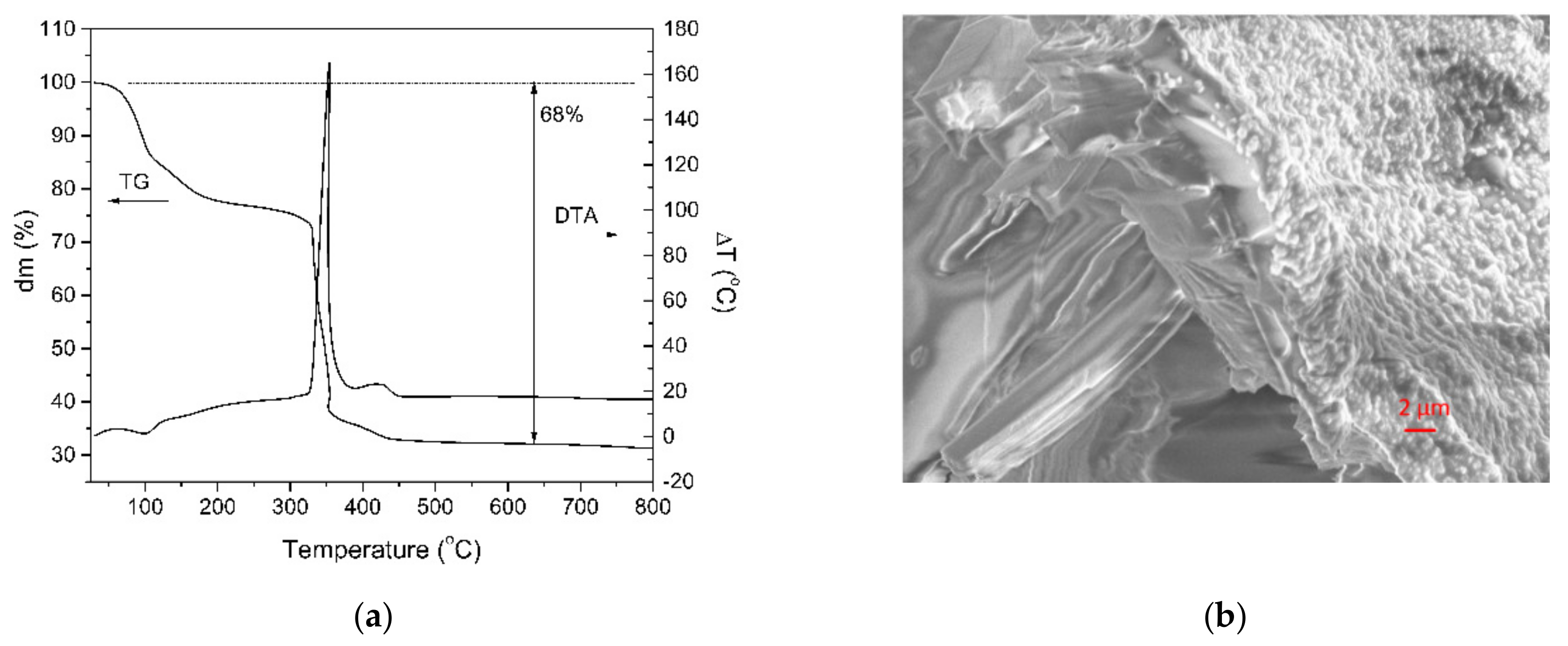
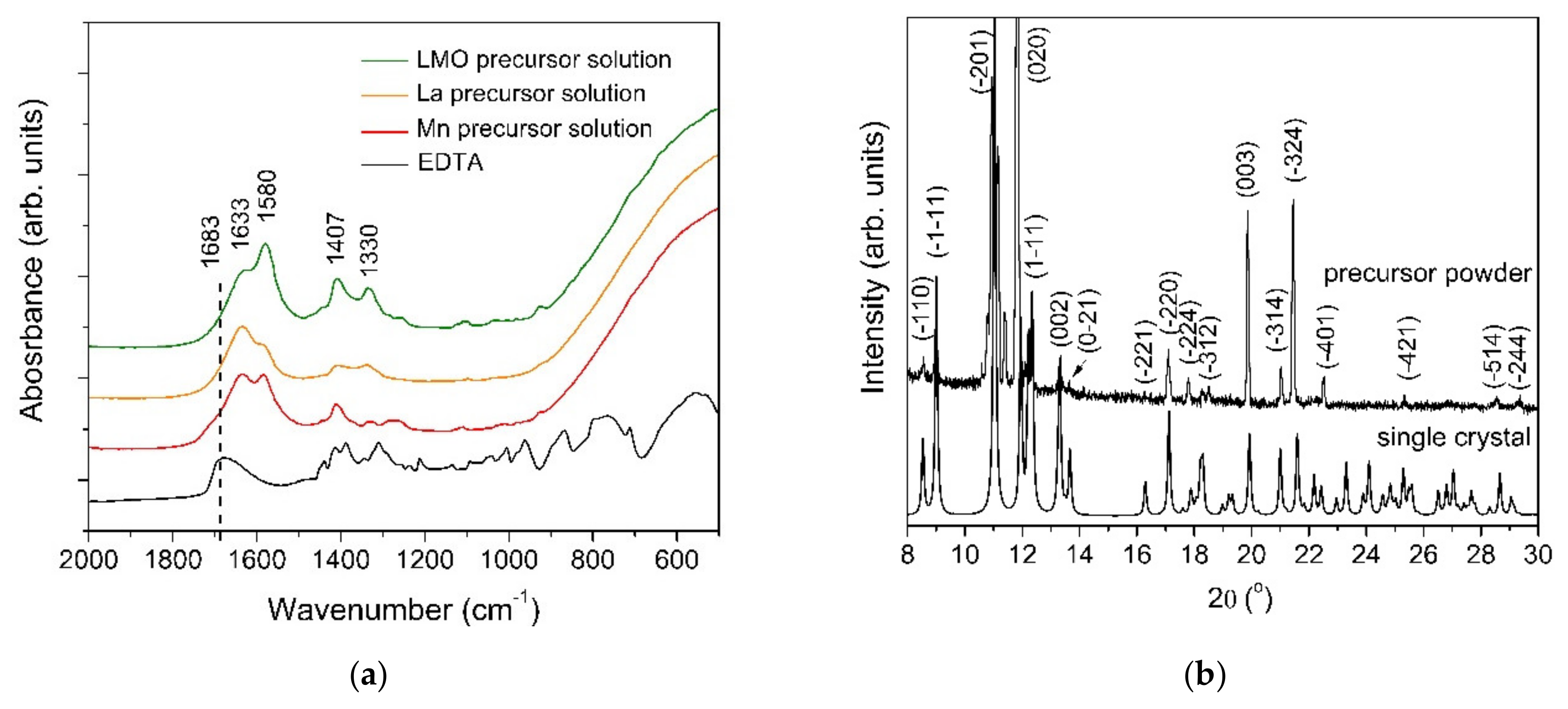
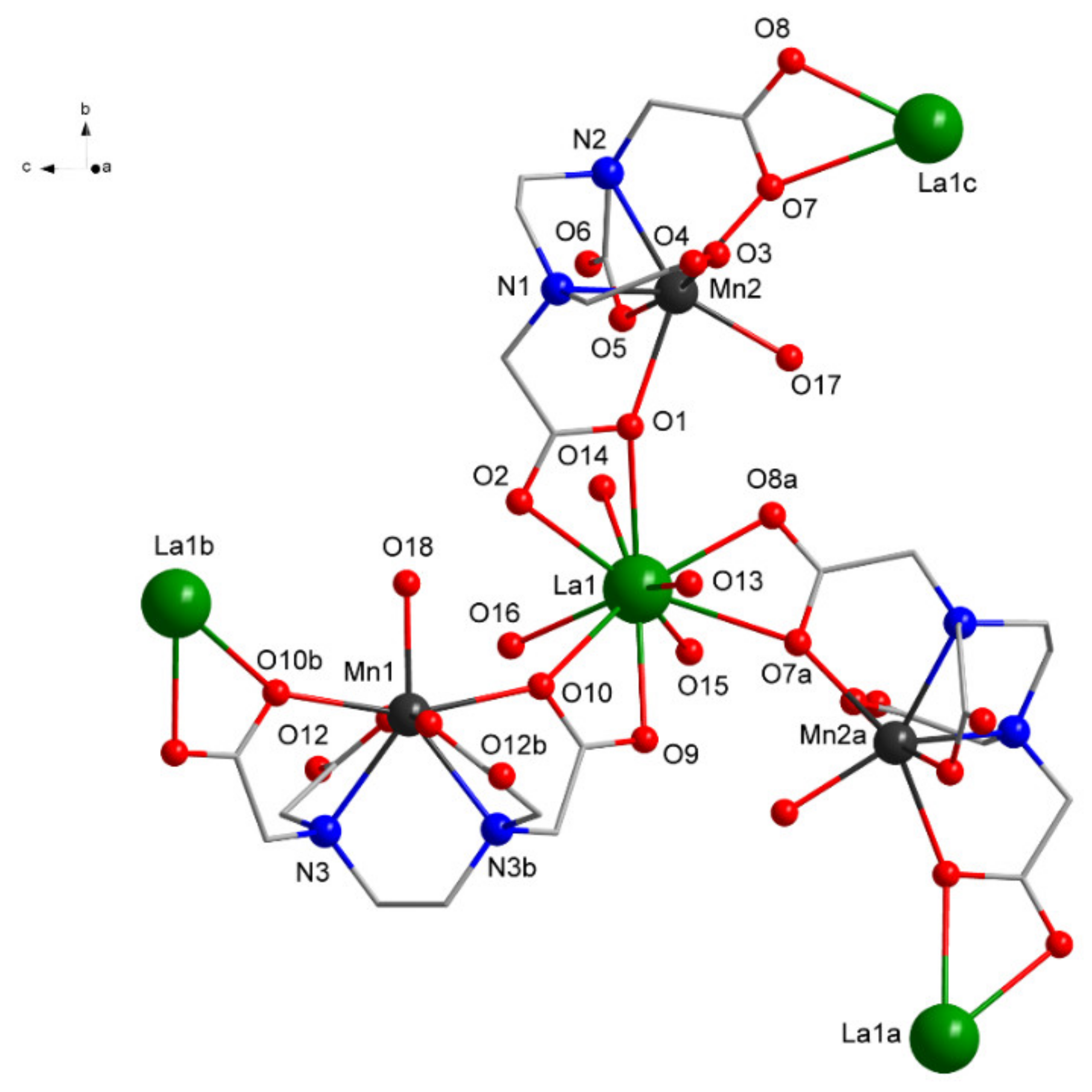
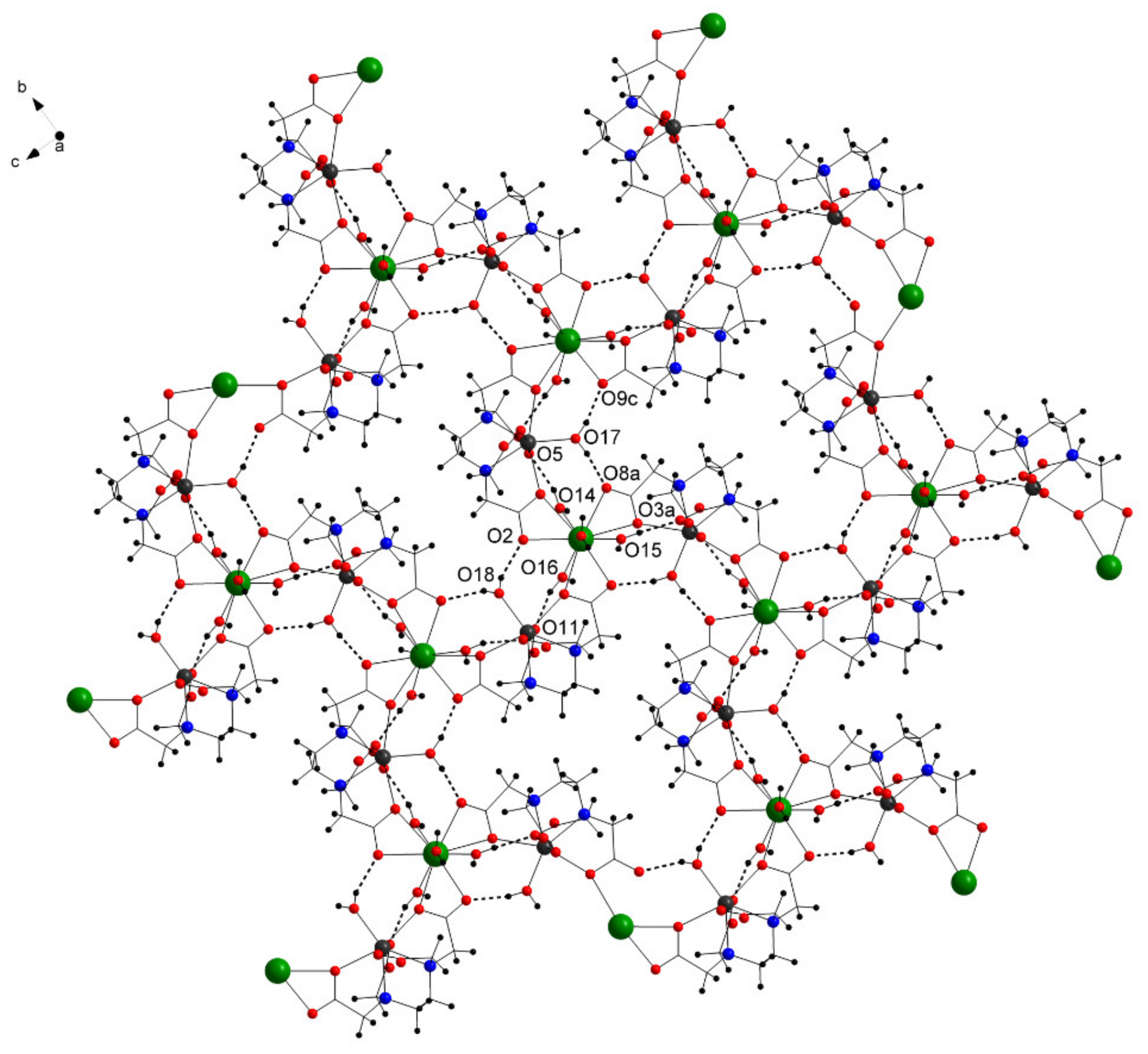
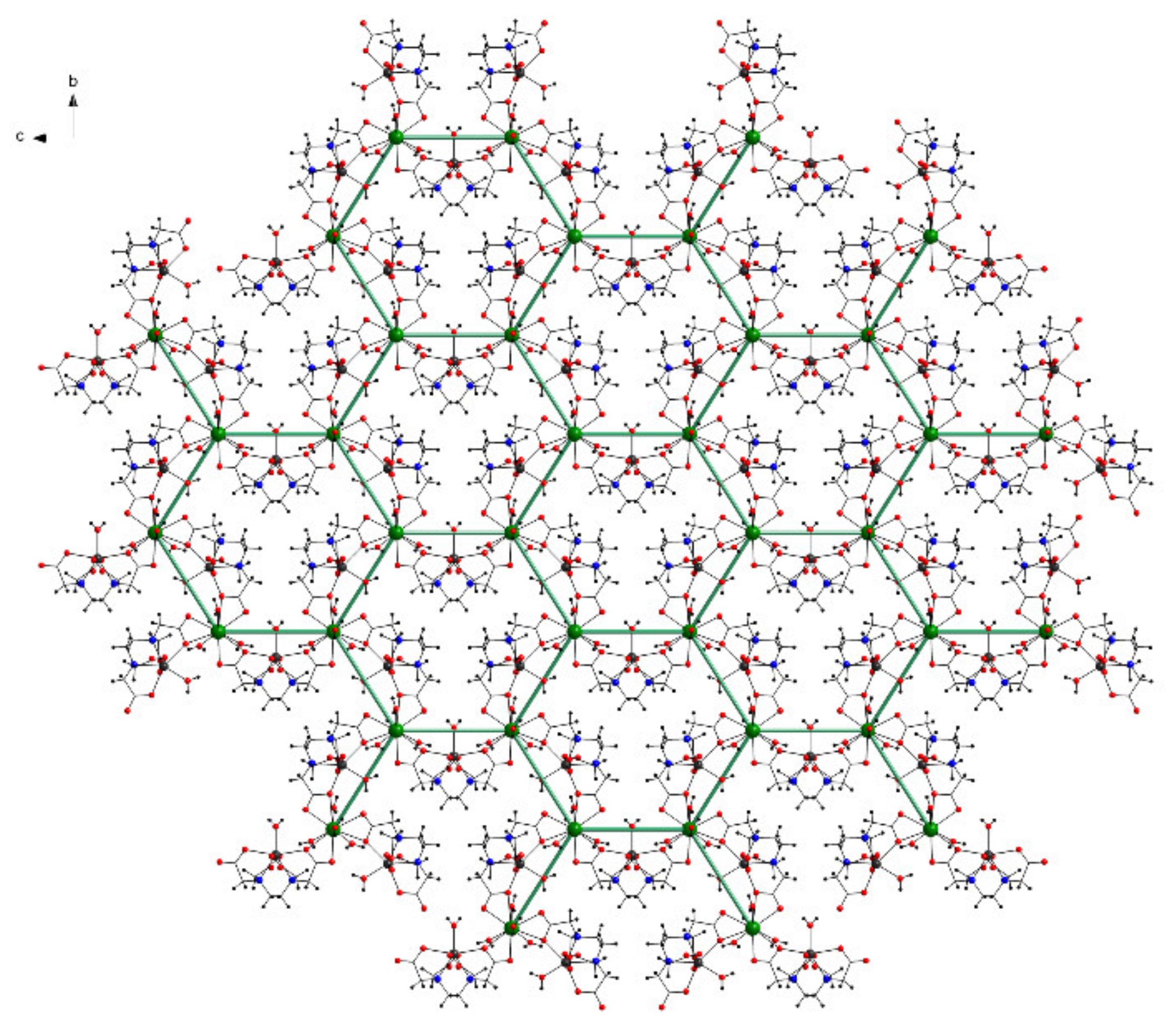
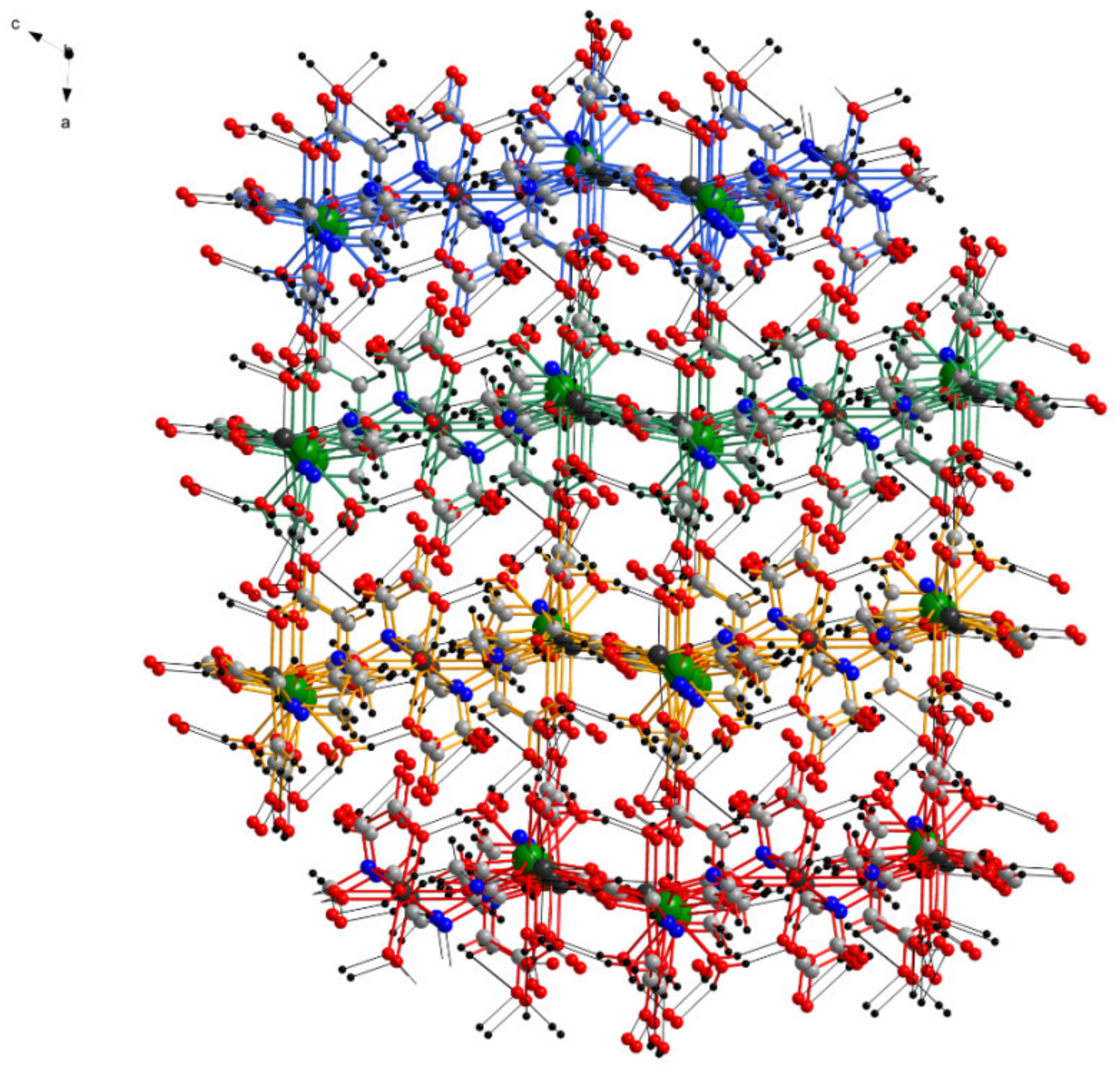

| Compound | 1 |
|---|---|
| Empirical formula | C30H58La2Mn3N6O47 |
| Formula weight | 1697.46 |
| Temperature (K) | 297(2) |
| Wavelength (Å) | 0.71073 |
| Crystal system | Monoclinic |
| Space group | C2 |
| Unit cell dimensions | |
| a (Å) | 16.1227(17) |
| b (Å) | 14.8049(16) |
| c (Å) | 14.8736(16) |
| α (°) | 90 |
| β (°) | 116.107(2) |
| γ (°) | 90 |
| Volume (Å3) | 3188.0(6) |
| Z | 2 |
| Dc (mg/cm3) | 1.768 |
| Absorption coefficient (mm−1) | 2.000 |
| F(000) | 1690 |
| Crystal size (mm) | 0.30 × 0.26 × 0.23 |
| θ range for data collection (°) | 1.525 to 25.004 |
| Reflections collected | 15110 |
| Independent reflections | 5597 [R(int) = 0.0365] |
| Refinement method | Full matrix least-squares on F2 |
| Data/restraints/parameters | 5597/48/461 |
| Goodness-of-fit on F2 | 1.020 |
| Final R indices [I > 2σ(I)] | R1 = 0.0319, wR2 = 0.0797 |
| R indices (all data) | R1 = 0.0342, wR2 = 0.0811 |
| Absolute structure parameter | −0.011(8) |
| Largest diffraction peak and hole, eA−3 | 0.891 and −0.353 |
| Atoms 1, 2 | d 1,2 (Å) X-ray | d 1,2 (Å) FT-IR | Atoms 1, 2 | d 1,2 (Å) X-ray | d 1,2 (Å) FT-IR |
|---|---|---|---|---|---|
| La(1)–O(1) | 2.747(6) | 2.708 | Mn(1)–O(10) | 2.339(5) | 2.325 |
| La(1)–O(2) | 2.576(6) | 2.565 | Mn(1)–O(11) | 2.191(6) | 2.172 |
| La(1)–O(7a) | 2.755(5) | 2.733 | Mn(1)–O(18) | 2.137(10) | 2.119 |
| La(1)–O(8a) | 2.530(6) | 2.545 | Mn(1)–O(11b) | 2.191(6) | 2.172 |
| La(1)–O(9) | 2.521(7) | 2.551 | Mn(1)–O(10b) | 2.339(5) | 2.325 |
| La(1)–O(10) | 2.799(5) | 2.711 | Mn(1)–N(3) | 2.380(6) | 2.355 |
| La(1)–O(13) | 2.562(5) | 2.539 | Mn(1)–N(2b) | 2.380(6) | 2.291 |
| La(1)–O(14) | 2.569(6) | 2.551 | |||
| La(1)–O(15) | 2.529(6) | 2.544 | Mn(2)–O(1) | 2.360(6) | 2.389 |
| La(1)–O(16) | 2.522(6) | 2.548 | Mn(2)–O(3) | 2.187(6) | 2.159 |
| Mn(2)–O(5) | 2.200(6) | 2.298 | |||
| Mn(2)–O(7) | 2.347(5) | 2.345 | |||
| Mn(2)–O(17) | 2.136(8) | 2.167 | |||
| Mn(2)–N(1) | 2.374(6) | 2.305 | |||
| Mn(2)–N(2) | 2.338(7) | 2.371 |
| D–H···A | Type | d(D–H) (Å) | d(H···A) (Å) | d(D···A) (Å) | <(DHA) (°) |
|---|---|---|---|---|---|
| O(14)–H(14D)···O(5) | intra | 0.85(4) | 1.96(3) | 2.786(8) | 164(9) |
| O(15)–H(15D)···O(3a) | intra | 0.86(6) | 1.96(7) | 2.802(9) | 167(12) |
| O(16)–H(16C)···O(11) | intra | 0.86(6) | 1.90(9) | 2.720(9) | 161(11) |
| O(17)–H(17C)···O(8a) | intra | 0.84(5) | 1.88(7) | 2.626(11) | 146(14) |
| O(17)–H(17D)···O(9a) | intra | 0.86(5) | 1.87(6) | 2.712(10) | 165(6) |
| O(18)–H(18D)···O(2) | intra | 0.85(6) | 2.00(7) | 2.765(7) | 150(7) |
| O(13)–H(13C)..O(6d) | inter | 0.84(6) | 2.05(6) | 2.864(11) | 162(7) |
| O(15)–H(15C)..O(4c) | inter | 0.85(9) | 1.82(9) | 2.628(12) | 159(8) |
| O(16)–H(16D)..O(4c) | inter | 0.85(7) | 1.89(8) | 2.691(12) | 157(9) |
© 2020 by the authors. Licensee MDPI, Basel, Switzerland. This article is an open access article distributed under the terms and conditions of the Creative Commons Attribution (CC BY) license (http://creativecommons.org/licenses/by/4.0/).
Share and Cite
Sonher, R.B.; Varga, R.A.; Nasui, M.; Jr, T.P.; Gabor, M.S.; Senila, M.; Rufoloni, A.; Petrisor, T.; Ciontea, L. Single Source Precursor for PAD-LaMnO3 Thin Films. Crystals 2020, 10, 851. https://doi.org/10.3390/cryst10090851
Sonher RB, Varga RA, Nasui M, Jr TP, Gabor MS, Senila M, Rufoloni A, Petrisor T, Ciontea L. Single Source Precursor for PAD-LaMnO3 Thin Films. Crystals. 2020; 10(9):851. https://doi.org/10.3390/cryst10090851
Chicago/Turabian StyleSonher, Ramona Bianca, Richard Attila Varga, Mircea Nasui, Traian Petrisor Jr, Mihai Sebastian Gabor, Marin Senila, Alessandro Rufoloni, Traian Petrisor, and Lelia Ciontea. 2020. "Single Source Precursor for PAD-LaMnO3 Thin Films" Crystals 10, no. 9: 851. https://doi.org/10.3390/cryst10090851
APA StyleSonher, R. B., Varga, R. A., Nasui, M., Jr, T. P., Gabor, M. S., Senila, M., Rufoloni, A., Petrisor, T., & Ciontea, L. (2020). Single Source Precursor for PAD-LaMnO3 Thin Films. Crystals, 10(9), 851. https://doi.org/10.3390/cryst10090851




